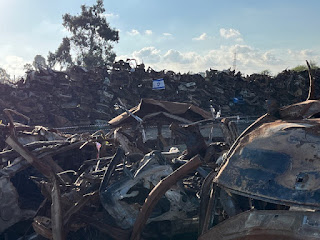
This is a map of Gaza and what Israelis call Otef Aza, the Gaza envelope. These are the Jewish communities that wrap around the border of Gaza and are within 7 Km (4 miles) of the rocket launchers in Gaza.
Today, along with dozens of other English-speaking Jews from the Greater Jerusalem area, we visited five of the sites connected with the massacre of October 7.
Our first stop was Kibbutz Be’eri, one of the communities that was the hardest hit. While waiting for kibbutz member Yardi Tzemach to show us some of the devastation of his community, I noticed on the sign that Kibbutz Be’eri was established in October 1946. That’s nearly two years before the founding of the State of Israel.

The pastoral Kibbutz Be’eri had 1200 members prior to the morning of October 7, 2023. Twenty-seven hours later, approximately one in 12 kibbutz members were dead.
By the time our group arrived in early January, the bodies and blood had long ago been cleared away. This sign, as well as the Hebrew spray painted on the house announces that ZAKA, Israel’s leading non-governmental rescue and recovery organization, certified the house as free of human remains.

What remained were the devastating signs of total destruction. Aside from the live artillery fire from the nearby war in Gaza, the first sound that impacted me was the jangling of nearly 50 pairs of human feet walking over shattered roof tiles. If you have ever been to Israel, you will likely recognize these as the mangled remnants of the distinctive orange roof tiles common to Jewish communities throughout the Land.

I bent over and took possession of a small piece of one of the tile fragments from one of the worst-hit homes, a somber souvenir.

Amidst the utter rubble, it is still possible to pick out what was once the family’s oven and dishwasher, with dishes still inside.

Over and over, I was struck by the artifacts of normal life that somehow survived – spots of color amidst so much charred grey.

We heard the story of Yardi’s brother Shachar who was one of a small number of men who fought against the terrorist invasion until 2:30 in the afternoon. Shachar was killed at the site of the kibbutz clinic just 30 minutes before the IDF arrived.
Our second stop was Shokeda, a religious moshav very close to Be’eri that was saved by an open miracle. On the morning of October 7, which was Shabbat as well as Simchat Torah, an IDF helicopter was downed, hit by Hamas fire, and landed in the fields of Shokeda. Fifty IDF soldiers emerged from the downed chopper and killed dozens of terrorists before they made it into the entrance of the moshav.
There’s a lot of empty land in this part of Israel. Our next stop was a huge tract of land where thousands of cars that were shot or burned on October 7 were brought. At this site, mounds and mounds of burned out automotive carcasses were visible.
And in the middle of all of them, someone climbed up the pile of automotive rubble and planted an Israeli flag.

About six weeks ago, an unprecedented decision was made to bury the cars still believed to contain human remains.
From the car yard, we went to Re’im, the site of the Nova music festival. All across the site are small memorials to the nearly 400 festival goers who were murdered there.
This memorial marked the spot where the dead body of one of the bartenders, Yaron Efraim, was found.

Throughout the field are poles with pictures of the victims.

Some of the poles are further decorated with small remembrances, such as stones and candles.



On this sign bearing the names of the 394 victims, three additional names are handwritten on the bottom left.

Our last stop was just outside of the religious moshav called Shuva, not far from Netivot. In the early days of the war, one family of brothers started feeding soldiers coming directly from the battlefront in northern Gaza. Their early efforts have blossomed and now the site feeds thousands of soldiers each and every day.
After a very hard day, bearing witness to bitter barbarism, being pounded again and again by the price our fellow citizens – the maimed and murdered, the burned, the injured, the captives and the displaced are paying – Shuva was a carnival.
We dropped off the bags and bags of purchases we brought to donate to the Shuva store, where soldiers can come and take anything they need – from tea bags to toiletries to thermals.

Joyful music played. Volunteers cooked and served burgers to the soldiers. We heard from one of the brothers about how their humble project has grown and grown and how the people of Israel just want to help.

.JPG)
This sign reads: v’ahavta l’reacha kamocha – Love your neighbor as you love yourself.
Rabbi Akiva says: “‘You should love your fellow as yourself’ is a basic principle of the Torah.”

It was, finally, at Shuva, enveloped in so much kindness, that I was overcome with tears. Click here to donate to the inspiring Shuva Brothers project.
Today, I witnessed the consequences of some of the most debased actions of humanity.
And I ended the day so fiercely proud of the inherent goodness of my people who, though battered and bleeding, want nothing more than to help.
NOTE: The government announced today that they will start allowing displaced citizens to return to their homes in certain parts of Otef Aza as early as mid-February. These trips will only be available for a short time. To join a trip scheduled for late January, contact Rabbi Moshe Rothschild at [email protected].

